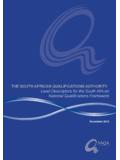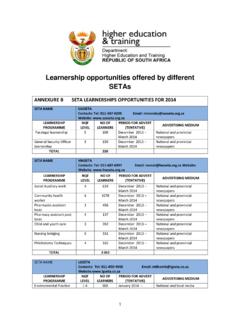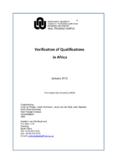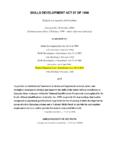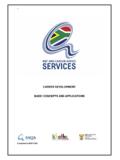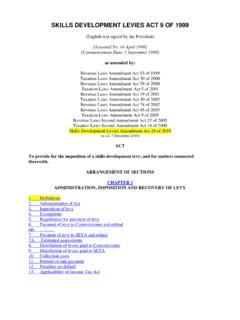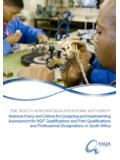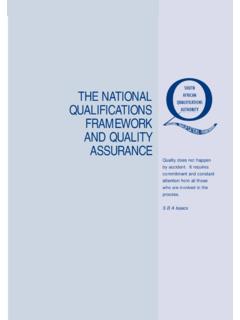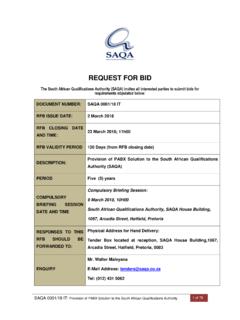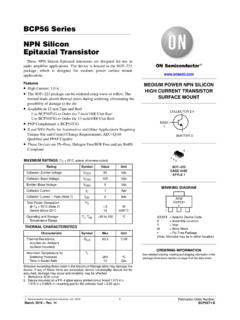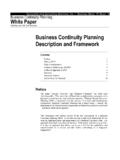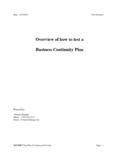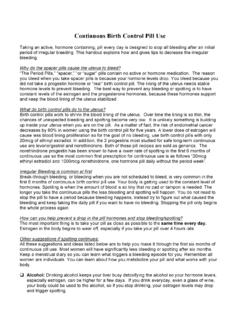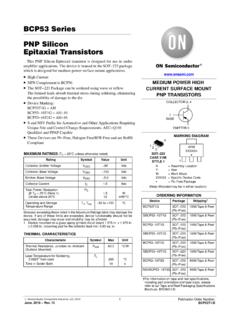Transcription of BUSINESS CONTINUITY PLAN
1 BUSINESS CONTINUITY plan Status: Approved Date: 2013-12-04 File Reference: 1 BUSINESS CONTINUITY plan Status: Approved Custodian: IT Directorate Date approved: 2013-12-04 Decision number: SAQA 07102/13 Implementation date: 2013-12-05 Due for review: 2016-12-03 File number: BUSINESS CONTINUITY plan Status: Approved Date: 2013-12-04 File Reference: 2 CONTENTS1 INTRODUCTION .. 4 2 GOALS AND OBJECTIVES .. 4 3 CORPORATE RESPONSIBILITIES .. 5 Crisis Control Unit .. 5 Concept .. 5 Risks and Balances .. 5 Crisis Control Unit 5 Disaster Declaration Authority .. 5 External Crisis Control Centre .. 6 BUSINESS Support Units (BSUs) .. 6 Strategic BUSINESS Units.
2 6 4 COUNTER DISASTER STRATEGY .. 6 Key 6 Risk 7 Determine Vulnerability to Uncontrollable Factors .. 7 Determine Vulnerability to Controllable Factors .. 8 Counter Disaster Measures .. 8 Physical Access .. 8 Health and Safety .. 8 Off-Site Recovery Centre .. 8 Fire Prevention .. 9 Uninterruptible Power Supply (UPS) .. 9 Server and Database Redundancy .. 9 IT Hardware Availability and Ease of Configuration .. 9 Location and Security of the Server Room .. Error! Bookmark not defined. Data and Software Back Ups .. 9 Communication Lines .. 10 Disaster Categories and Levels .. 10 Logic Behind The Category Definitions .. 10 Category 1 Disasters.
3 10 Category 2 Disasters .. 10 Category 3 Disasters .. 11 Table 2 Disaster Categories and Levels .. 11 Monitoring and Escalation .. 11 Restoration and Return .. 12 5 MAINTENANCE OF THE OVERALL BCP plan .. 12 BUSINESS Impact Analysis .. 12 Current/Normal 12 Minimum (Post Disaster) Requirements .. 13 Maximum Recovery Time .. 13 Recovery Teams and Roles .. 13 Public Relations .. 13 Development of the plan .. 13 Capturing and Maintaining the plan .. 14 6 TESTING THE plan .. 14 Inspections .. 14 BUSINESS CONTINUITY plan Status: Approved Date: 2013-12-04 File Reference: 37 TRAINING .. 14 8 A RECOVERY PROCESS SCENARIO .. 14 Immediate Action .. 15 Disaster Declaration.
4 15 Announcement and Notification .. 15 Unit Responsibilities .. 16 Directorates BUSINESS Support Units .. 16 Human Resources .. 16 Finance and Insurance .. 16 Communication (ACS) .. 16 Information Technology .. 16 Directorates .. 17 BUSINESS CONTINUITY plan Status: Approved Date: 2013-12-04 File Reference: 41 INTRODUCTION The concept of BUSINESS CONTINUITY Planning (BCP) has over the past few years, become a major BUSINESS management requirement. For example the King II report highlights the responsibility of the board to support BUSINESS sustainability under normal as well as under adverse operating conditions. The internationally recognized Standard ISO 17799 and the BS7799 requires that a managed process be implemented for developing and maintaining BUSINESS CONTINUITY throughout an organization.
5 The subject has been well researched and a great deal of documentation and advice is available. Specialist BCP companies have emerged, offering the BUSINESS community a range of BUSINESS CONTINUITY products and services, including: Off-site recovery facilities; Planning methodologies; and Software based Disaster Recovery Planning (DRP) systems ; This has given rise to the evolution of DRP specific terminology and acronyms. Disaster Recovery Planning is also known as BCP ( BUSINESS CONTINUITY Planning) or BRP ( BUSINESS Resumption Planning). It has become generally acknowledged that the planning process should go beyond catering for major disasters such as earthquakes, fire and flood, to include the less threatening emergencies like power outages, server downtime and limited access to the workplace, which start out as minor emergencies, but can quickly escalate to full blown disasters.
6 There can be no standard methodology regarding BCP as much depends on: The type of BUSINESS addressed; The main office environment (campus or single building); Enterprise locations infrastructure; Existing vulnerabilities; Reliance on networking and location of servers; Executive management attitudes; and Cost of putting BCP in place. In line with the SAQA policy on BUSINESS CONTINUITY , this document presents the SAQA plan for all aspects of BCP and serves as an important background to the detailed action plan , which due to its changeable nature is presented as separate documents per directorate. 2 GOALS AND OBJECTIVES The goal of the plan is to prevent loss of life, reduce property damage and minimise impact on the overall BUSINESS : Minimise and support the number of decisions that must be made during a crisis; Minimise the dependence on any specific person during the crisis; Minimise the need to perform crisis actions by trial-and-error when a crisis occurs; and Minimise the need to develop new procedures, programs or systems during a crisis so that all components necessary to assist the site during a crisis are documented and stored off-site, ready for use.
7 The overall objective of the plan is to provide the information and procedures necessary to: - Rapidly respond to a disaster or emergency situation; Notify necessary trained personnel; Assemble BUSINESS recovery teams; Rapidly recover services to clients; and Rapidly resume normal BUSINESS functions. BUSINESS CONTINUITY plan Status: Approved Date: 2013-12-04 File Reference: 53 CORPORATE RESPONSIBILITIES CRISIS CONTROL UNIT CONCEPT The concept of a Crisis Control Unit requires careful explanation. The unit should not exist as a day-to-day ongoing BUSINESS entity, but the members come together as a team, to orchestrate all matters relating to an actual or potential disaster and the ongoing task of Disaster Recovery Planning, including the implementation of disaster prevention activities.
8 The unit members include some of the most senior members in the organisation and are ultimately responsible for all aspects of disaster prevention and disaster recovery, relating to SAQA. Any team, even at this level, requires an internal orchestrator to ensure that the team operates effectively despite ongoing day-to-day responsibilities that are not disaster related. With this in mind a senior management role has been created in the group viz. Crisis Control Officer (CCO). The CCO will be a senior person with a good understanding of the BUSINESS and BUSINESS practices together with a detailed knowledge of the Information Technology on which the BUSINESS has become so dependant.
9 The CCO together with his/her deputy, will be responsible for the development, ongoing maintenance and testing of an effective Disaster Recovery plan and disaster prevention measures. The CCO must ensure that all members of the Crisis Control Unit understand all aspects of the BUSINESS CONTINUITY plan and are fully aware of their respective responsibilities in this area. Whilst the Crisis Control Unit carries ultimate responsibility for all facets of disaster recovery, specific responsibility lies in the across all BUSINESS units disaster related activities. The Crisis Control Unit, through the Crisis Control Officer will also be responsible for ensuring that each Strategic BUSINESS Unit (SBU) has developed a BUSINESS specific BUSINESS CONTINUITY plan which clearly states and covers the key BUSINESS processes of the unit and is in line with the corporate BUSINESS CONTINUITY plan , as determined by the Crisis Control Unit.
10 RISKS AND BALANCES From a crisis control perspective the perennial question is How much is enough? What would happen in a major disaster if the entire Crisis Control Unit were lost? On the other hand it does not make sense to have a Crisis Control Unit that is so large that it becomes unwieldy. The plan assumes that the required quorum of the Crisis Control Unit will remain functional, in a post disaster situation. CRISIS CONTROL UNIT MEMBERS Title Name Major DR Function Chief Executive Officer Joe Samuels Leadership and group PR IT Director Herman Ohlhoff Crisis Control Officer CFO Mark Albertyn Financial Support NLRD Director Yvonne Shapiro Database Administration HR Director Victor Booysen Staff matters ACS Director John Arnesen Communication DISASTER DECLARATION AUTHORITY A major disaster (evacuation of site) will take place as per SAQA s Procedures on Emergency Evacuation.
